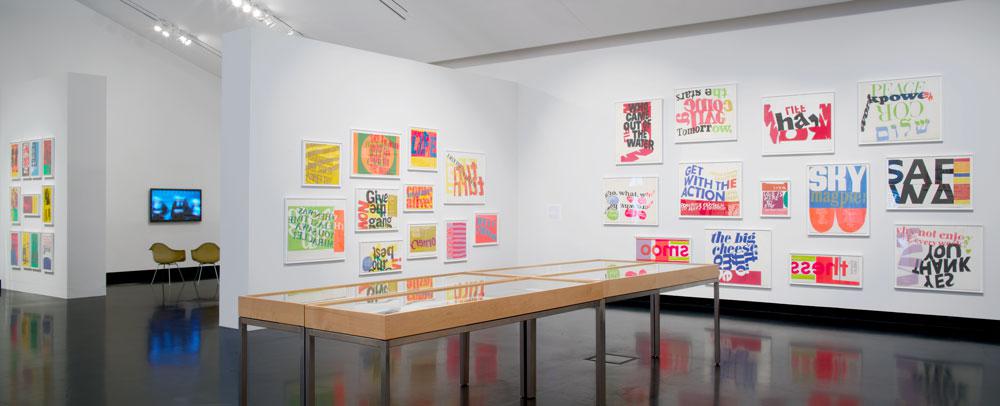Corita Kent (1918–1986) was an innovative printmaker and radical Catholic nun (a Sister of the Immaculate Heart of Mary) who taught at Immaculate Heart College in Los Angeles from 1946 to 1968. While Kent’s work has long been celebrated, particularly by graphic artists and designers—and especially by those in Los Angeles, home of the Corita Art Center—Julie Ault’s 2006 monograph Come Alive! The Spirited Art of Sister Corita and exhibitions such as the Contemporary Art Gallery’s first Canadian solo exhibition of her work in 2011, “To create is to relate,” have reminded us of the vitality, influence and contemporaneity of Kent’s work in recent years.
Located at Skidmore College, a liberal arts college in Saratoga Springs, New York, the Tang Teaching Museum is an ideal venue for this first “full-scale survey” of Kent’s work, particularly as it places her open-hearted and generous alternative pedagogy at the core of her practice.
A key touchstone in the exhibition, in fact, is We Have No Art, a short experimental documentary made in 1967 (at the height of Kent’s renown) by Baylis Glascock. It’s primarily set in Kent’s classroom as she works closely with her students to encourage them to see the world through fresh eyes and to develop art’s capacity for social and political change. The art department’s slogan was taken from Marshall McLuhan via a Balinese proverb: “We have no art, we do everything as well as we can.” (Kent’s oft-reproduced “rules” for the department are worth reading to grasp their teaching philosophy.)
Kent’s prints were reproduced in different formats and widely circulated—a grassroots form of communication that altered the urban landscape. As her friend, the theologian Harvey Cox described, she transformed the “commonest of the everyday” into “a vehicle of the luminous, the only, and the hope filled.” (It’s also worth noting that her life and practice reached into Canada; part of her childhood was spent in Vancouver, and she taught grade school in British Columbia in the 1940s.)
This sprawling exhibition is quite simply a joy. Organized into a dozen distinct installations, “Someday Is Now” includes more than 200 individual works, primarily serigraphs on paper or on the textile Pellon. It unfolds roughly chronologically, from her beginning work in the 1950s and early 1960s to her iconic designs combining her faith and her activism in the mid- to late 1960s to her more introspective work created after leaving Los Angeles and the Church for Boston in the 1970s to the placid watercolours she made in her retirement in the 1980s. All of this is present in addition to several vitrines full of fascinating ephemera.
Text plays a prominent role in Kent’s screenprints, drawing on her own moving, humanistic writing as well as quotes from a variety of writers (of poetry, prose, scripture, jingle, and pop): Rainer Maria Rilke, Helen Keller, Gertrude Stein, George Harrison, the Bhagavad Gita and Leonard Cohen are just a few of those cited.
Such catholic tastes (sorry) are reflected in Kent’s visual vocabulary as well, as she drew on everything from product packaging and advertising to the history of graphic arts (such as the early 20th-century posters referenced in 1968’s circus alphabet, one of her two striking alphabets on view here), in what the Tang calls “her own version of Pop art.” Form and function are perfectly, playfully intertwined as she delivers profound spiritual and political messages in the most winsome visual language conceivable.
A number of the prints turn advertising’s promises of consumer fulfillment and life transcendence on their ear as she applies their slogans to communal and spiritual struggles rather than the trafficking of tomato sauce or breakfast cereal. One of her technical innovations was a technique for skewing and morphing printed text, which brings a great dynamism to the posters, making the printed word sculptural.
The prints’ colours vibrate with riotous energy, and the Tang exploits the tall ceilings of their idiosyncratic Antoine Predock–designed building to create an explosion of her eye-popping prints stretching from floor to ceiling, wall to wall. (Kent’s work is ideally suited for being seen in such a quantity and density: joy is cumulative.)
The exhibition’s title “Someday Is Now” evokes the idea that our desires—namely, for peace and justice—must not only be worked towards for consummation in the afterlife, but should be achieved in the here and now; Kent strived for this daily through her extensive anti-war, anti-poverty and civil rights work. As one serigraph puts it: “Man fully alive / Is the glory of God.” Her faith was in humanity, and it is a testament to her work’s success that it is so compelling to audiences of all persuasions: Kent’s gospel is infectious.









